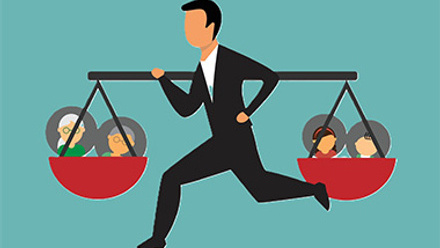The difference between stress and burnout: how to support employees
A certain amount of ‘pressure’ at work can be positive, as it can increase performance and help us prepare for challenges ahead. But if the pressure remains high for an extended period, it can lead to a negative stress reaction, distress or even employee burnout. If stressors are not managed, this can be detrimental to employee health and to a business.
If you’re observing team members who are disillusioned and completely exhausted, this may be more than a stress reaction, they may be on the road to burnout. Understanding what signs to look out for is the first step, followed by knowing how to support employees in regaining balance.
When things are busy, or we have too much on our plate, it is natural to feel a certain amount of stress. But there is a difference between stress and burnout. Typically, people who are under stress can see a future where once everything becomes more manageable, they’ll feel better. When we are left with relentless pressure, we may be unable to see an end and struggle to cope, resulting in burnout.
What is burnout?
Burnout is a state of physical and emotional exhaustion. It can occur when you experience long-term sustained stress in your job or when you have worked in a physically or emotionally draining role for a long time.
Excessive work-related stress can feel like you’re drowning in responsibilities, whereas burnout is a sense of helplessness or feeling trapped or defeated.
There are a series of signs and symptoms of burnout to look out for:
- withdrawing from responsibilities
- taking out frustrations on those around you
- skipping work
- being late for work or necessary appointments
- isolating from others
- procrastinating, taking longer to get things done
- using food, drugs, or alcohol to cope.
Physical signs and symptoms of employee burnout can include:
- feeling tired or drained most of the time
- lowered immunity, frequent illnesses
- frequent headaches or muscle pain
- change in appetite or sleep habits.
Emotional signs and symptoms of burnout can include:
- a sense of failure and self-doubt
- feeling helpless, trapped, and defeated
- detachment, feeling alone in the world
- loss of motivation
- increasingly cynical and negative outlook
- decreased satisfaction and sense of accomplishment.
Employers have a ‘duty of care’ under UK law to protect employees’ health, safety and welfare. Employers must also assess the risks of workplace hazards, including work-related stress. So it can be helpful as a manager to ask yourself the following questions about a colleague you may be concerned about:
- Are they frequently working late?
- Do co-workers often ask this person for help? And does this person always oblige?
- Do they allow their diary to be filled with back-to-back meetings without allowing time for goal-directed work?
- Are they taking breaks or have buffers between things in their diary?
- Do they tend to work until all of their work is done?
How to reduce stress and risks of employee burnout in the workplace?
It’s critical to be aware of employees’ workplace issues and prioritise employee wellbeing. We know that employers who support their employees are more likely to see positive impacts on productivity, absenteeism, presenteeism, time management, and other key factors that lead to better work outcomes and also employee attraction and retention.
Preventing stress in the workplace begins with education. Whether a small company or large corporate employer, prioritising wellbeing and providing mental health training for your workforce should be higher up your agenda.
Mental health training helps everyone in the workplace. Line managers and the senior leadership team can lead from the top, modelling the importance of mental health and wellbeing whilst learning the tools for providing a mentally fit workplace that is good for business. Removing the taboo is vital to early detection of stress, preventing burnout and future-proofing employee mental health.
Training can help employees learn to use early identification principles, spot the signs and symptoms of common mental health issues, provide non-judgemental support and reassurance, and guide a person to seek professional support where appropriate.
Supplied by REBA Associate Member, Onebright
Onebright is a personalised on-demand mental healthcare company.








